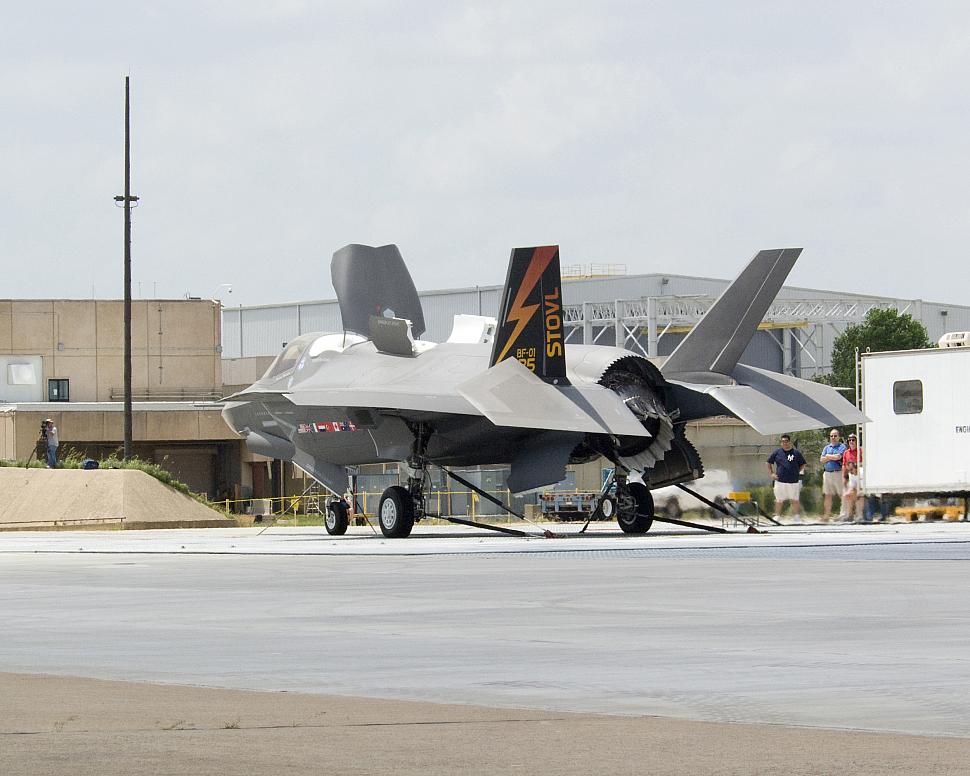Fighter Jet News
F-35 Lightning II News
F-35B completes STOVL propulsion ground test
May 29, 2008 (by
Asif Shamim) -
Lockheed Martin tested the shaft driven lift fan propulsion system on the F-35B Lightning II, performing short takeoffs and vertical landings (STOVL) for the first time during ground testing on Sunday, May 25.

The F-35 is a supersonic, multi-role, 5th generation stealth fighter. When at full power, the F-35B's system generates more than 40,000 pounds of lifting force, or about 170 percent more than current-generation STOVL fighters.
Graham Tomlinson, pilot from BAE Systems performed two conversions from conventional (wing-borne flight) to STOVL (jet-borne) mode with the aircraft anchored to a specially instrumented hover pit at Lockheed Martin’s STOVL Operations Test Facility. The F-35B is conducting a final series of ground tests before its first flight in the coming weeks.
"The F-35B's STOVL propulsion system operated exactly as expected, providing the power output that our models forecast and transitioning very smoothly from conventional to STOVL-mode and back," said Bobby Williams, Lockheed Martin vice president and F-35 deputy program manager. "We expect the same kind of seamless transition when the F-35B begins STOVL-mode flights in early 2009."
The F-35B STOVL propulsion system has logged more than 1,900 hours of operation on test stands. In 2001 the X-35B, used a prototype of the same propulsion system, completing 14 short takeoffs, 17 vertical takeoffs and 27 vertical landings. Later on, on July 20, 2001, the X-35B entered the history books by becoming the first aircraft to perform a short takeoff, accelerate to supersonic speed in level flight and descend for a vertical landing in a single mission.
During the initial series of flights the F-35B will operate in conventional mode to evaluate overall flying status and airworthiness. In preparation for the F-35B’s first flight, Tomlinson flew the F-35A for the first time on May 28, assessing the aircraft’s handling at various power settings. Early on in 2009, the F-35B will conduct initial STOVL flight trials before moving to Naval Air Station Patuxent River, for further testing.
Sunday's test marked the first use of the newly constructed hover pit and its supporting facilities. "Our aim is to retire technical risk well before we deliver F-35s to the fleet," Williams said. "Our investment in facilities like the hover pit is helping us do just that while building confidence in the test program."
The F-35 comes in three variants, derived from a common design and will replace at least 13 types of aircraft for 11 nations.

The F-35B Lightning II tethered to a specially instrumented hover pit with its powerful engine running, tests its propulsion system in short takeoff/vertical landing (STOVL) mode on May 25th, 2008 at Lockheed Martin in Fort Worth, Texas. [Lockheed Martin photo]
Graham Tomlinson, pilot from BAE Systems performed two conversions from conventional (wing-borne flight) to STOVL (jet-borne) mode with the aircraft anchored to a specially instrumented hover pit at Lockheed Martin’s STOVL Operations Test Facility. The F-35B is conducting a final series of ground tests before its first flight in the coming weeks.
"The F-35B's STOVL propulsion system operated exactly as expected, providing the power output that our models forecast and transitioning very smoothly from conventional to STOVL-mode and back," said Bobby Williams, Lockheed Martin vice president and F-35 deputy program manager. "We expect the same kind of seamless transition when the F-35B begins STOVL-mode flights in early 2009."
The F-35B STOVL propulsion system has logged more than 1,900 hours of operation on test stands. In 2001 the X-35B, used a prototype of the same propulsion system, completing 14 short takeoffs, 17 vertical takeoffs and 27 vertical landings. Later on, on July 20, 2001, the X-35B entered the history books by becoming the first aircraft to perform a short takeoff, accelerate to supersonic speed in level flight and descend for a vertical landing in a single mission.
During the initial series of flights the F-35B will operate in conventional mode to evaluate overall flying status and airworthiness. In preparation for the F-35B’s first flight, Tomlinson flew the F-35A for the first time on May 28, assessing the aircraft’s handling at various power settings. Early on in 2009, the F-35B will conduct initial STOVL flight trials before moving to Naval Air Station Patuxent River, for further testing.
Sunday's test marked the first use of the newly constructed hover pit and its supporting facilities. "Our aim is to retire technical risk well before we deliver F-35s to the fleet," Williams said. "Our investment in facilities like the hover pit is helping us do just that while building confidence in the test program."
The F-35 comes in three variants, derived from a common design and will replace at least 13 types of aircraft for 11 nations.
Related articles:
External link:
Forum discussion:
Tags
- F-35 STOVL engine powered up in preparation of first flight ( 2008-04-27)
- PW completes Altitude Testing for F-35 STOVL Motor ( 2008-04-06)
- First F-35 STOVL unveiled at Lockheed Martin ( 2007-12-19)
- F-35 STOVL team completes successful gearbox test ( 2007-05-07)
- First STOVL F-35 Joint Strike Fighter takes shape at BAE Systems ( 2006-07-06)
- F-35 Lightning II news archive
External link:
Forum discussion:
- F-35B Comes to life ( 22 replies)
Tags
